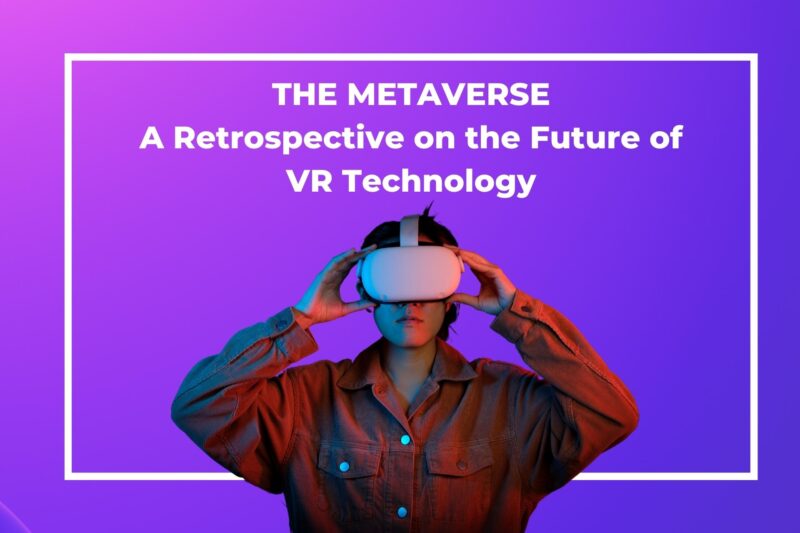Embark on a journey through the Metaverse, reflecting on the evolution of VR technology and its futuristic potential. Gain valuable insights into the past, present, and future of virtual reality.
From training to virtual conferences, businesses everywhere are discovering new ways to use the technology. The Metaverse is a VR world built on top of the existing internet. It features user-friendly avatars and enables users to explore connected virtual spaces with ease. Users can create persistent digital representations of themselves called Avatars, which they can use to meet other Users or AI characters in the Metaverse regularly or just hang out as their digital self when they’re not physically present somewhere else. Furthermore, users have control over what kind of interactions they have with other Users through various privacy settings while also having access to a wide range of services such as real estate property listings, auctions, job marketplaces and more.
The Future of VR: Where is it headed and why?
Virtual reality is far more than just a technology aimed at entertainment or leisure. It offers new ways of seeing the world by completely immersing people in environments that feel so real that the lines between fantasy and reality often become blurred. Furthermore, VR can also be used to help solve important problems in many different industries. It has the potential to transform the way we interact with technology, reduce social anxiety, improve health outcomes, and more. VR will also likely play a major role in shaping the future by influencing people’s perceptions of what is possible. VR can help us visualize far-off places and things in ways never before possible.
Virtual Reality in Business?
Virtual Reality (VR) is increasingly being used to improve the way businesses operate. From marketing training, VR is being integrated with organizational strategies. Employees can use VR to train in realistic environments without having to travel and risk injury. Companies can also use VR to house important data and products in digital form, which can be interacted with through avatars. VR is a powerful tool that can help businesses succeed. The VR market is expected to grow from $7 billion in 2018 to $22 billion by 2023, with software revenue accounting for $8 billion in revenue. There are many reasons why businesses should consider adopting VR. Improved efficiency – VR can help improve the efficiency of a business by reducing travel costs and time spent on training. More immersive customer experience – Businesses can use VR to create more immersive customer experiences in areas such as product design and marketing. Increased employee engagement – VR can improve employee engagement by making work more interesting and enjoyable.
VR for Gaming
VR is a lot more than just a technology aimed at entertainment. It offers new ways of seeing the world by completely immersing people in environments that feel so real that the lines between fantasy and reality often become blurred. There are many reasons why VR has grown in popularity as a medium for gaming over the years. For starters, VR offers a more realistic gaming experience than traditional video games do. It allows players to become part of their game, which is something that can’t be replicated through traditional gaming platforms. VR also provides a new level of social interaction between players, which makes gaming both more engaging and enjoyable. VR is a lot more than just a technology aimed at entertainment. It offers new ways of seeing the world by completely immersing people in environments that feel so real that the lines between fantasy and reality often become blurred. Furthermore, VR has helped games transcend many cultural and social barriers by providing an accessible and interactive medium that anyone can enjoy.
VR for Education
Education is a field that stands to benefit greatly from VR technology. VR can be used to create immersive environments that students can explore and experience first-hand. VR can be used to create fully simulated environments, such as those that simulate the inside of a space station or a tropical rainforest. VR can also be used to bring historical events, such as famous speeches or battles, to life. VR can also be used for educational purposes outside the classroom. It can be used for remote patient care and training, as well as for social skills training. VR can even be used for parenting skills training, as well as for teaching children how to use technology safely. VR offers many benefits for education. It is an engaging and interactive medium that can help students better understand complex topics and events. It can also help break down cultural and social barriers by providing a safe environment for students to learn about topics that are unfamiliar to them.
VR for Healthcare and Rehabilitation
Healthcare is another industry that stands to benefit greatly from VR technology. VR can be used to create fully simulated environments, such as those that simulate the inside of a spaceship or a raging storm. VR can also be used to bring historical events, such as famous speeches or battles, to life. VR can also be used to help treat patients suffering from anxiety disorders by helping them confront their fears in a controlled setting. VR can also be used to help treat psychological disorders such as post-traumatic stress disorder (PTSD). VR can also be used as a tool for pain relief, as well as for rehabilitation after an injury. VR offers many benefits for healthcare. It is an engaging and interactive medium that can help patients better understand complex topics and events. It can also help break down cultural and social barriers by providing a safe environment for patients to learn about topics that are unfamiliar to them.
VR offers new ways of seeing the world by completely immersing people in environments that feel so real that the lines between fantasy and reality often become blurred. It is a powerful tool that can help us visualize far-off places and things in ways never before possible. The future of virtual reality is bright. Technology has come a long way since its humble beginning. There are many reasons to believe that VR will become even more widespread in the future. The VR market is expected to grow significantly in the coming years, and VR technology has come a long way since its humble beginning.








